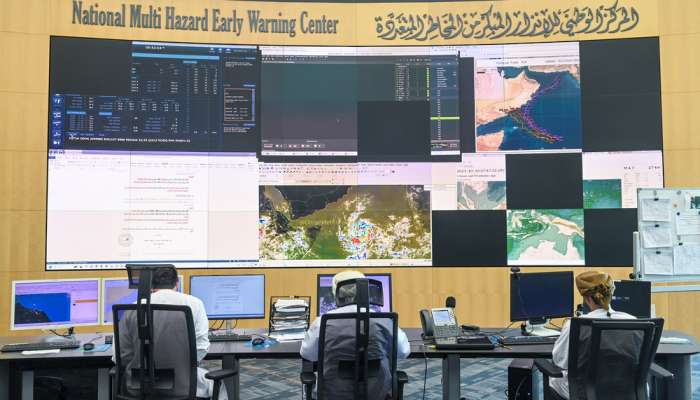
MUSCAT: The Sultanate of Oman has developed an integrated infrastructure for early warning systems and work is underway for the modernisation of the satellite and numerical models to achieve accurate forecasts.
The installation of early warning system ‘Muzn’ has helped enhance the level of accuracy of the meteorological services, which allowed governments, communities and individuals to act and prepare better for the adverse weather conditions.
Abdullah bin Rashid Al Khaduri, Director General of Meteorology at the Civil Aviation Authority, said: “Muzn has helped develop the quality of alerts, meteorological services, early warning, and improved systems and devices in the National Multi Hazard Early Warning Centre (NMHEWS).
“It has also improved the technology solutions and digital transformation processes, and enabled us to train and qualify the national cadre, technically and practically.”
Oman had launched the initial National Multi Hazard Early Warning System in 2015. The system, implemented with the technical support of the Intergovernmental Oceanographic Commission (IOC) of UNESCO, was designed to respond to natural hazards, including tsunamis, cyclones and flash floods.
The system was the result of a collaboration between the IOC – UNESCO and Oman that began in 2009. It supports monitoring conditions of weather and sea, data processing and standard operating procedures, as well as training of personnel and the operation of sea-level stations.
The system includes monitoring, data processing, and standard operating procedures. The collaboration included training and capacity building, as well as the installation and operation of sea-level stations.
The latest National Multi Hazard Early Warning System was launched officially on March 23 this year in Muscat. It has been designed to respond to national water-related hazards.
Oman is subject to Makran tsunamis and far-field tsunamis from the Sunda Trench, tropical cyclones, and flash floods.
Al Khaduri said, “Most countries have proceeded with developing the early warning systems to reduce the costs resulting from the impacts of climate change. Oman has also invested in strengthening the National Multi Hazards Early Warning Centre through the development of the machines and systems in line with climate change.”
He said that climate change results in the number of cyclones and weather conditions that could affect countries worldwide. “Tropical cyclones in Oman caused fatalities in 2007 (Gonu) and widespread damages were witnessed during Phet in 2010. However, since the start of the early warning system, there has been a drastic decrease in human and material losses,” he added.
Al Khaduri said: “Following the Royal Directives of His Majesty Sultan Haitham Bin Tarik for development of the early warning system and mainly the National Multi Hazards Early Warning Centre, there is further upgradation under Muzn programme that would continue to 2026. Through this programme new radars for early warning would be initiated and a new radar would be installed in Musandam Governorate. The satellite system would also be developed along with the development of the numerical models which enable accurate forecasting of all changes related to weather conditions.”